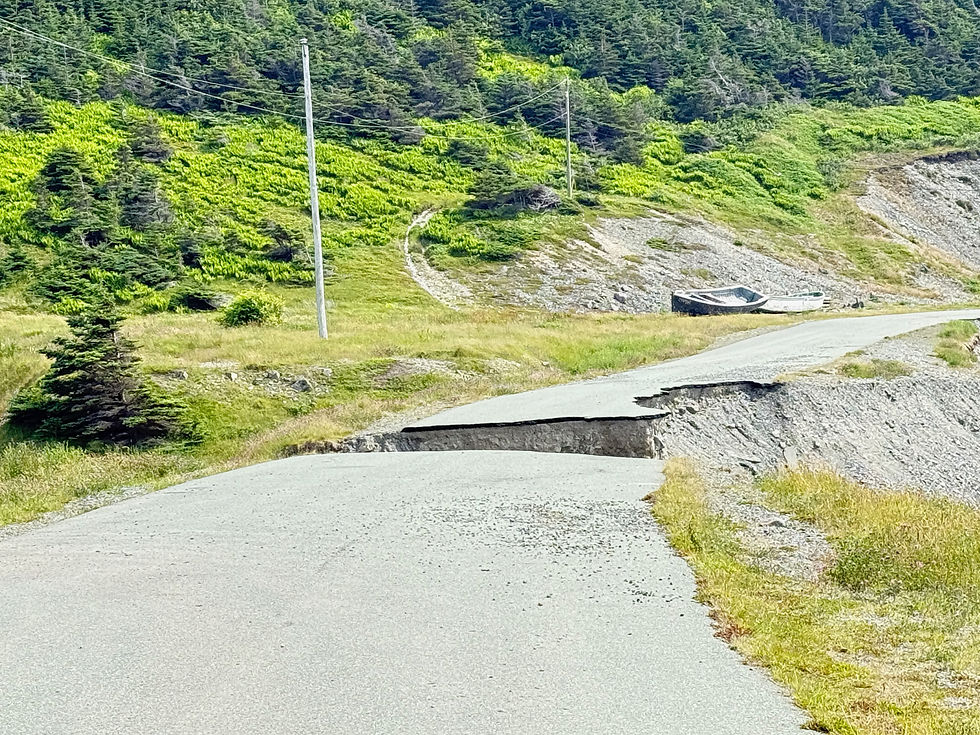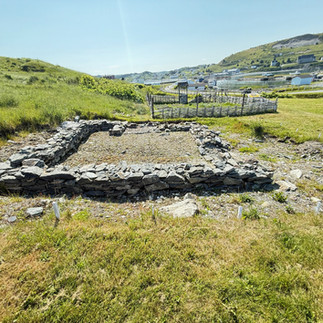The Irish Loop: A Day of Discovery and Difficult Choices on Newfoundland's Avalon Peninsula
- Kim Martinez

- Jul 18
- 6 min read
Updated: Jul 22
The Irish Loop
We decided to tackle the famous "Irish Loop" – a scenic 175-mile drive around the southern portion of the Avalon Peninsula. Our plan was ambitious but sensible: pace ourselves to explore coves, trails, and towns rather than just logging highway miles. That was our good intention, anyway, and it started out exactly that way.

The Journey Begins
Departing from our home base at Bluefin RV Park in Holyrood, we headed toward Bay of Bulls and Witless Bay. The harbors and boats were picturesque, but we didn't linger long – we had serious ground to cover. Throughout the drive, we stopped at countless coves to admire the stunning cliffs and ocean views, but we dedicated extra time to four special stops that truly captured our hearts.
The Reality of "Next Time" Lists
Here's where those good intentions met reality. After covering our planned territory, we faced the traveler's eternal dilemma: skip towns and experiences to fit everything in, or accept that some treasures would have to wait for "next time."
What Made Our "Next Time" List:
- Mistaken Point Ecological Reserve: The only place in the world where you can view 565-million-year-old deep-sea floors that perfectly preserve ancient ecology – but the tour requires advance booking and lasts four hours
- Trepassey: Where Amelia Earhart took off to become the first woman passenger on a transatlantic flight
- Salmonier Nature Park: A wildlife park that deserved proper time, but daylight was fading by the time we reached it
What We Did Experience

1. Tors Cove: A Perfect Leg-Stretcher
We enjoyed a quick hike with beautiful scenery at this access point to the coastal trail. While you can follow the trail for miles, we explored about a mile before needing to walk along a road to catch the next section. It's an ideal spot to stretch your legs and take in some lovely views before moving on.

2. Brigus South: A Netflix-Perfect Fishing Village
This quaint fishing village drew us in with its fascinating mix of charming Newfoundland-style homes, typical abandoned buildings, and a picture-perfect harbor. We hiked up the mountain behind the town, which rewarded us with an almost eerie view of a dark blue hole where ocean waters rush toward the town, blocked by ancient boulders.
Dark Blue cove that is kept back from the town harbor by some boulders.
The plot twist? We discovered from locals that the town was "a little too perfect" because it had been staged for filming a Netflix series about a sea monster terrorizing a Newfoundland community. Amazingly, they didn't need to change much – just a few building modifications to create the right ambiance. The ocean setting was authentically moody all on its own. We'll definitely be watching for that series!
3. Colony of Avalon: Walking Through 400-Year-Old History

Located in present-day Ferryland, the Colony of Avalon is one of North America's most significant early colonial archaeological sites, and it absolutely lived up to its reputation.
The Historical Background:
- Founded in 1621 by Sir George Calvert (later Lord Baltimore)
- One of the earliest planned English settlements in North America
- Calvert brought his entire family to live in Avalon, but after one brutal winter, they departed for warmer climates and founded Maryland instead
What Makes It Archaeological Gold:
The ongoing excavations have uncovered millions of original colony artifacts, incredibly well-preserved thanks to the cold climate and soil conditions. The site has revealed building foundations, including what's believed to be North America's first flush toilet!
Our Experience:
Remains of actual foot walls, cobblestone streets, left over from the early 1600's!
We took the excellent 45-minute guided tour with period-dressed interpreters who brought colonial life to vivid reality. Walking through the actual ruins, we could clearly see building footings, fireplace areas, and how all the structures fit together. The highlight was walking on the original cobblestone road – still intact several feet below the surface after being buried for centuries. Standing on those same stones that witnessed all the history we'd just learned about was genuinely moving.
Our guide Lucille, a local with wonderful stories and authentic tales, explained the colony's tumultuous history of attacks by the Dutch and French, multiple burnings, and eventual abandonment. She also shared that anyone can join the summer "digs" – after some supervision, you get your own one-foot area and sifters to search for artifacts. With only 25-35% of Avalon excavated so far, there's plenty of history still waiting to be discovered!
A Charming Side Story:
Lucille pointed out a large island dotted with white spots – sheep! Her father's family brings their sheep to the island each May, leaving them to graze until November roundup. With no predators, fresh water, and abundant grass, the sheep thrive. The roundup isn't always easy though – they herd the experienced older sheep first, hoping the rest will follow. We used our binoculars to confirm the sheep sightings!
The Setting:

The site overlooks beautiful Ferryland harbor with numerous islands nearby. The crystal-clear water was stunning everywhere we looked. The protected harbor made perfect sense for Avalon's location – relatively easy to defend, deep enough for ships, and with lighthouse positioning that allowed spotting approaching vessels from far away.
What makes it extra special is the thin peninsula jutting out toward the lighthouse, with beautiful blue-water beaches on both sides. Beaches are rare in this cliff-dominated area, making this doubly precious.




How Did Avalon Get "Lost"?
This was my burning question. Here's the fascinating story:
After Calvert abandoned the colony in 1629, Sir David Kirke and his brothers took control, with David becoming Newfoundland's first royal governor. The Kirke family operated the settlement until the 1650s-1660s, when political changes in England (including the English Civil War) affected colonial holdings. The settlement gradually declined, focusing on seasonal fishing operations, and by the late 1600s was largely abandoned.
Over time, the site was literally buried under centuries of soil, vegetation, and later development. Local knowledge of the exact location faded into legend rather than documented history. It wasn't until locals kept finding artifacts while digging root cellars and basements that historians took serious interest. Archaeological work didn't begin until the 1990s, and the incredible preservation was actually due to the site being "lost" – no one had disturbed those layers of history!
Due to budgets and harsh winters, excavations happen only eight weeks each summer with archaeologists and university students. Joining for a day or more is definitely on our "next time" list – I can see how finding something would become addictive, and the chances are pretty high!
4. Ferryland Lighthouse: A Harrowing Drive Worth Taking

After finishing the Avalon tour, we continued toward the lighthouse via a narrow, one-lane dirt road with sheer cliff drop-offs and minimal pull-outs for oncoming traffic. We parked with considerable relief!
The lighthouse, built in 1871 and still active today, requires about a 25-minute uphill walk through acres of trails with captivating scenery. Currently open to the public, it's also home to Lighthouse Picnics – order delicious food ahead of time and it'll be waiting when you arrive. We didn't plan far enough ahead for this option, but it's definitely on our "next time" list.
Note: Visitors who want the lighthouse experience but struggle with the 25-minute walk can get transported for a small fee.
5. St. Stephens & St. Vincents Beach: Whale Watching Hop
After miles away from the water, St. Stephens provided one of the best ocean views on our route. Like many Newfoundland towns, it's experiencing population decline – from 313 in 2016 to 263 in 2021. Combined with St. Vincents Beach, the total population reaches 340!

Coming in from St. Stephens & Peter River

What Makes It Unique:
Nearly three miles of cobblestone beaches with plenty of parking access. These cobblestones attract capelin fish to "roll in" and lay eggs – a whale's favorite treat! The water deepens so quickly that huge whales often come within just 10 meters of shore.
We brought chairs and joined other hopeful whale watchers for a picnic. While we didn't spot whales, we were thoroughly entertained by diving Northern Gannets – quite impressive and fun to watch.

We also explored St. Stephens, walking along the Peter River and discovering why a road was closed off: Hurricane Larry in 2021 had created a huge break in the road and left broken concrete dock remnants in the water.
The Journey Home
By late afternoon, with so many incredible sites bouncing around in our heads, we began the final 60 miles back to our RV park.

We stopped to enjoy the sunset outside St. Mary's and arrived back at Bluefin after dark, heads full of history and hearts full of "next time" plans.

































Comments